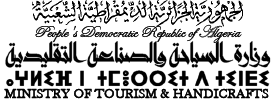Wilaya of Ouled Djellal
 created as Wilaya by Law No. 12-19 of 12/11/2019 after its creation as an administrative district in 2015 by Presidential Decree 15-140 composed of two daïras, Ouled Djellal and Sidi Khaled, surrounding six (06) municipalities, Ouled Djellal, Doucen and Chaïba, Sidi Khaled, Besbes and Ras El Miaad.
created as Wilaya by Law No. 12-19 of 12/11/2019 after its creation as an administrative district in 2015 by Presidential Decree 15-140 composed of two daïras, Ouled Djellal and Sidi Khaled, surrounding six (06) municipalities, Ouled Djellal, Doucen and Chaïba, Sidi Khaled, Besbes and Ras El Miaad.With an estimated population of 223,343
It is limited by:
- In the North: The wilaya of Msila
- To the West: the wilaya of Biskra
- In the South: the wilayas of El Oued and Ouargla.
- To the East: The wilaya of Djelfa
Located in the southwest of the wilaya of Biskra, it is only partially part of the whole formed by the Zab mountains and also includes vast steppe territories in the southwest of the region.
The geographical position at the foot of the Atlas, gives it a role of crossroads between the North and the South of the country; which makes the city of Ouled Djellal the gateway to the desert. This territory is a structural and sedimentary transition zone between the north of the mountainous country and the vast expanses of the Sahara: it is the lower Sahara bordered by the southern flank of the Saharan Atlas it would have been born from a Berber oasis, while the oasis of Sidi Khaled would have been created by the Khoualid, coming from the south-west of the Saharan Atlas, in the 15th century and who are at the origin of the creation of the palm grove.
Located on the RN 46 Which represents the artery connecting the north and the south, as well as its diversified relief of the plains of rocky mountains in a desert which extends within sight offer unique and picturesque landscapes, and places of leisure and comfort for visitors, which gives it a strategic character that can be a tourist attraction
All these factors make the Wilayat of Ouled Djellal a likely future tourist destination.
Ouled Djellal conceals a natural and cultural heritage, enjoying a certain originality and authenticity. These resources could, in the long term through appropriate development, constitute a considerable lever for the development of tourism and the development of tourism in this territory.
The Ouled Djellal region essentially occupies the southern foothills of the ZAB mountains, between Bou Saada and Biskra. It is a Saharan region which, beyond the Djedi wadi, presents interesting archaeological riches. There are several discovery stations.
We can cite the following remains:
Oued El Assel, a small tributary of the Djedi wadi, in the locality of Hassi Cida where the discovery of instruments from the Capsian period was made;
Bordj and Berrout wells, located about twenty km northwest of the town of Ouled Djellal, near Chaïba, discovery of end scrapers and debris from blades of a Capsian appearance;
Doucen, discovery of instruments from the Capsian period; Sidi Khaled, with the discovery of cut flints.
The large Errahba square is home to shops specializing in embroidery, in particular burnous and kachabia using threads of all colors and very varied patterns; this activity is considered a work of art.
Oued Djellal is associated in the local social imagination with a multitude of memories, images, legends, heroes, saints and poets, both sacred and legendary. Sidi Khaled in particular evokes a long holy history as evidenced by the burial of Khaled Ibn Sinân housed in the mosque of the same name, located on the south bank of Oued Djedi. The cemetery that surrounds it includes a square of the Dwawda tribe, where the famous Hayzia originated, whose beauty was celebrated by the poet Ben Guitoune. Sidi Khaled is also famous for its reputation as a city of famous lyric poets and singers (Khelifi Ahmed, Ba Ammar …) who are part of the line of the first poets by making known the ch’ir el malhoun.
Ouled Djellal was also a stopover for pilgrims from the Maghreb en route to Mecca, as described by the traveler EL Ayachi in the 17th century.


